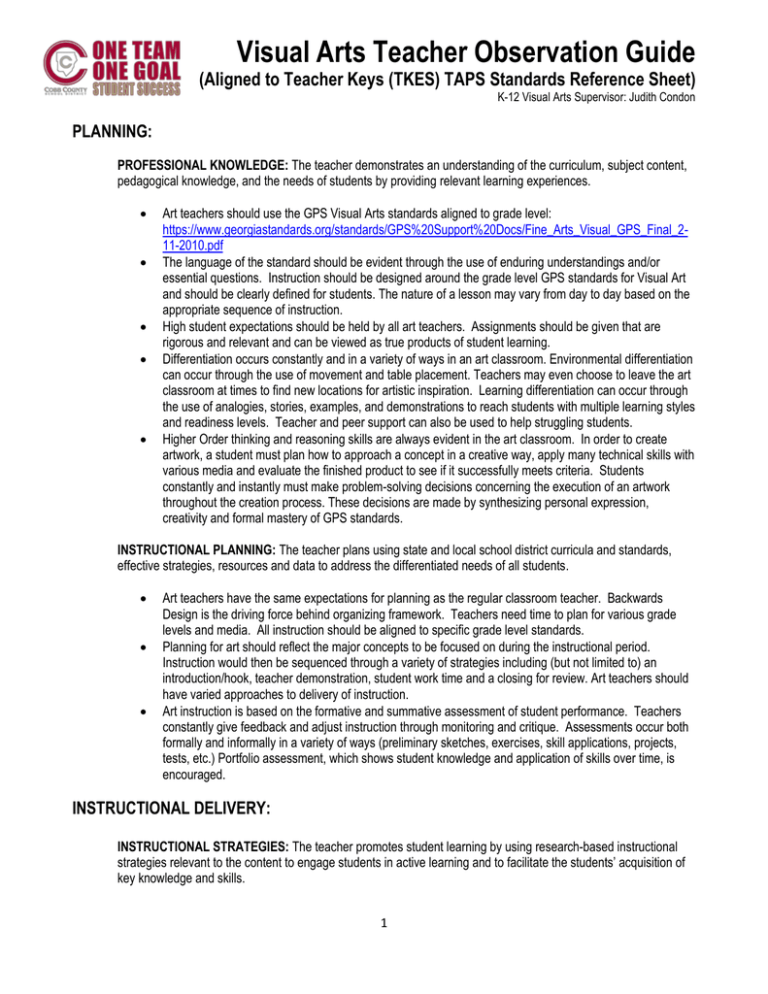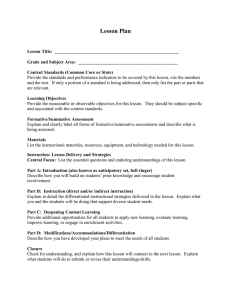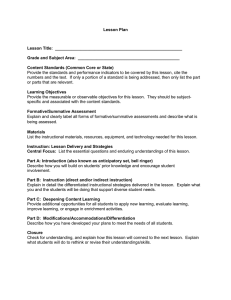TKES Visual Arts Teacher Observation Guide
advertisement

Visual Arts Teacher Observation Guide (Aligned to Teacher Keys (TKES) TAPS Standards Reference Sheet) K-12 Visual Arts Supervisor: Judith Condon PLANNING: PROFESSIONAL KNOWLEDGE: The teacher demonstrates an understanding of the curriculum, subject content, pedagogical knowledge, and the needs of students by providing relevant learning experiences. Art teachers should use the GPS Visual Arts standards aligned to grade level: https://www.georgiastandards.org/standards/GPS%20Support%20Docs/Fine_Arts_Visual_GPS_Final_211-2010.pdf The language of the standard should be evident through the use of enduring understandings and/or essential questions. Instruction should be designed around the grade level GPS standards for Visual Art and should be clearly defined for students. The nature of a lesson may vary from day to day based on the appropriate sequence of instruction. High student expectations should be held by all art teachers. Assignments should be given that are rigorous and relevant and can be viewed as true products of student learning. Differentiation occurs constantly and in a variety of ways in an art classroom. Environmental differentiation can occur through the use of movement and table placement. Teachers may even choose to leave the art classroom at times to find new locations for artistic inspiration. Learning differentiation can occur through the use of analogies, stories, examples, and demonstrations to reach students with multiple learning styles and readiness levels. Teacher and peer support can also be used to help struggling students. Higher Order thinking and reasoning skills are always evident in the art classroom. In order to create artwork, a student must plan how to approach a concept in a creative way, apply many technical skills with various media and evaluate the finished product to see if it successfully meets criteria. Students constantly and instantly must make problem-solving decisions concerning the execution of an artwork throughout the creation process. These decisions are made by synthesizing personal expression, creativity and formal mastery of GPS standards. INSTRUCTIONAL PLANNING: The teacher plans using state and local school district curricula and standards, effective strategies, resources and data to address the differentiated needs of all students. Art teachers have the same expectations for planning as the regular classroom teacher. Backwards Design is the driving force behind organizing framework. Teachers need time to plan for various grade levels and media. All instruction should be aligned to specific grade level standards. Planning for art should reflect the major concepts to be focused on during the instructional period. Instruction would then be sequenced through a variety of strategies including (but not limited to) an introduction/hook, teacher demonstration, student work time and a closing for review. Art teachers should have varied approaches to delivery of instruction. Art instruction is based on the formative and summative assessment of student performance. Teachers constantly give feedback and adjust instruction through monitoring and critique. Assessments occur both formally and informally in a variety of ways (preliminary sketches, exercises, skill applications, projects, tests, etc.) Portfolio assessment, which shows student knowledge and application of skills over time, is encouraged. INSTRUCTIONAL DELIVERY: INSTRUCTIONAL STRATEGIES: The teacher promotes student learning by using research-based instructional strategies relevant to the content to engage students in active learning and to facilitate the students’ acquisition of key knowledge and skills. 1 Visual Arts Teacher Observation Guide (Aligned to Teacher Keys (TKES) TAPS Standards Reference Sheet) K-12 Visual Arts Supervisor: Judith Condon The art classroom is an active and engaging place where students are encouraged to explore, create, collaborate and build their knowledge and skills in the visual arts. Art classrooms allow for considerable movement and noise due to the nature of instruction and learning through performance assessment. Quality art instruction should include many modalities and standards that cover art history, art production, art criticism and art aesthetics. This means that in any given art period an observer can see many activities. The format of the visual arts curriculum also lends itself naturally to personal response and differentiation. Visual Art instructional strategies are research and skill-based and are constantly changing and evolving. Teachers should be strongly encouraged to experiment with new concepts and media in the art classroom without fear of failure or reprimand. As in all arts courses, art teachers are constantly assessing the in-class performance of the students during activities. Students are engaged in formative and summative performance tasks. Technology integration is often used in the art classroom and is encouraged (Smart Board, Luna camera, LCD, computers, I-Pads, digital cameras, etc.). Technology can be used directly by the teacher and should also be used for interactive student learning. DIFFERENTIATED INSTRUCTION: The teacher challenges and supports each student’s learning by providing appropriate content and developing skills which address individual learning differences. The visual art curriculum lends itself naturally to differentiation. Students may be given the same set of criteria to meet when creating a project, but the products will all look different based on personal interpretation, creativity and skill level. Differentiation may also occur as needed through student modifications and accommodations. Teachers may also choose to add criteria to or adjust project criteria/assignments for students who need acceleration. Differentiation occurs constantly and in a variety of ways in an art classroom. Environmental differentiation can occur through the use of movement and table placement. Teachers may even choose to leave the art classroom at times to find new locations for artistic inspiration. Learning differentiation can occur through the use of analogies, stories, examples, and demonstrations to reach students with multiple learning styles and readiness levels. Teacher and peer support can also be used to help struggling students. ASSESSMENT OF AND FOR LEARNING: ASSESSMENT STRATEGIES: The teacher systematically chooses a variety of diagnostic, formative and summative assessment strategies and instruments that are valid and appropriate for the content and student population. ASSESSMENT USES: The teacher systematically gathers, analyzes, and uses relevant data to measure student progress, to inform instructional content and delivery methods and to provide timely and constructive feedback to both students and parents. Art teachers use formative assessment (formally and informally) to constantly adjust instruction to meet student needs. These formative assessments may include informal questioning, sketch evaluation, informal teacher and group critique, quizzes, and skill-based inquiry. Art teachers use diagnostic strategies regularly through classroom observation. An art teacher can observe technique and application of media to identify strengths and weaknesses of students. Teachers may also choose to have students take diagnostic assessments such as tests, quizzes, etc. throughout a learning unit. 2 Visual Arts Teacher Observation Guide (Aligned to Teacher Keys (TKES) TAPS Standards Reference Sheet) K-12 Visual Arts Supervisor: Judith Condon Summative strategies include finished artworks, formal critiques and portfolio assessment. Critique is a constant in an art class. Students are provided criticism in both the individual and group context. Students are also expected to self-critique. Feedback may be oral or written depending on the specific assignment. LEARNING ENVIRONMENT: POSTIVE LEARNING ENVIRONMENT: The teacher provides a well-managed, safe and orderly environment that is conducive to learning and encourages respect for all. ACADEMICALLY CHALLENGING ENVIRONMENT: The teacher creates a student-centered, academic environment in which teaching and learning occur at high levels and students are self-directed learners. Art classroom rules should be well-defined and clearly posted to help maintain safety and productivity. Teachers should have clear procedures to for students to follow as class begins, during individual work time, during critiques and when cleaning up materials. The idea that an art classroom should be “spotless” is unrealistic. An art classroom should be wellorganized and evidence of activity and engagement in various media should be evident. Teachers should maximize instructional time by minimizing disruptions and maintaining clear and effective procedures. Teachers should also provide curriculum-based extension activities for students who may finish assignments early and provide a reasonable amount of time for students to finish projects that may have fallen behind. Diversity is celebrated in the art room and teachers should have procedures in place to recognize student achievement and accomplishments (recognition, certificates, exemplary artist board, etc.) Art teachers should have an effective behavior management system in place. This system should encourage students to take responsibility for their own behavior and learning. Disruptive students may experience temporary isolation, exclusion from certain media, and project differentiation depending on the nature of the behavior. PROFESSIONALISM AND COMMUNICATION: see TAPS Standards 2014-15 Visual Arts theme/focus: GEMM: Genuine, Engaging, Modern and Meaningful! 3





